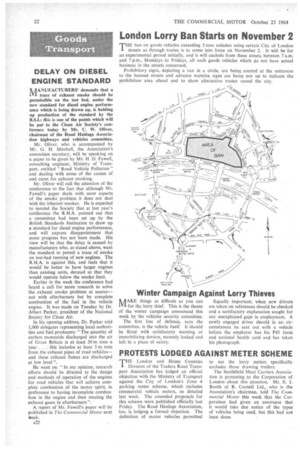DELAY ON DIESEL ENGINE STANDARD
Page 24

If you've noticed an error in this article please click here to report it so we can fix it.
MANUFACTURERS' demands that a trace of exhaust smoke should be permissible on the test bed, under the new standard for diesel engine performance which is being drawn up, is holding up production of the standard by the B.S.I.; this is one of the points which will be put to the Clean Air Society's conference today by Mr. C. W. Oliver, chairman of the Road Haillage Association highways and vehicles committee.
Mr. Oliver, who is accompanied by Mr. G. H. Mitchell, the Association's committee secretary, will be speaking on a paper to be given by Mr. H. D. Fawell, consulting engineer, Ministry of Transport, entitled "Road Vehicle Pollution' and dealing with some of the causes of and cures for exhaust smoking.
Mr. Oliver will call the attention of the conference to the fact that although Mr. Fawell's paper deals with most aspects of the smoke problem it does not deal with the inherent smoker. He is expected to remind the Society that at last year's conference the R.H.A. pointed out that a committee had been set up by the British Standards Institution to draw up a standard for diesel engine performance, and will express disappointment that more progress has not been made. His view wilt be that the delay is caused by manufacturers who, as stated above, want the standard to permit a trace of smoke on test-bed running of new engines. The R.H.A. is against this, and feels that it would be better to have larger engines than existing units, derated so that they would operate below the smoke limit.
Earlier in the week the conference had heard a call for more research to solve the exhaust smoke problem at source— not with afterburners but by complete combustion of the fuel in the vehicle engine. It was made on Tuesday by Dr. Albert Parker, president of the National Society for Clean Air.
In his opening address, Dr. Parker told 1,000 delegates representing local authorities and fuel producers: "The quantity of carbon monoxide discharged into the air of Great Britain is at least 20 tn. tons a year . . . this includes at least 5 in. tons from the exhaust pipes of road vehicles— and these exhaust fumes are discharged at low level ".
He went on: "In my opinion, research efforts should be directed to the design and methods of operation of the engines for road vehicles that will achieve complete combustion of the motor spirit, in preference to having incomplete combustion in the engine and then treating the exhaust gases in afterburners".
A report of Mr. FaweIl's paper will be published in The Commercial Motor next week.
02




















































































































